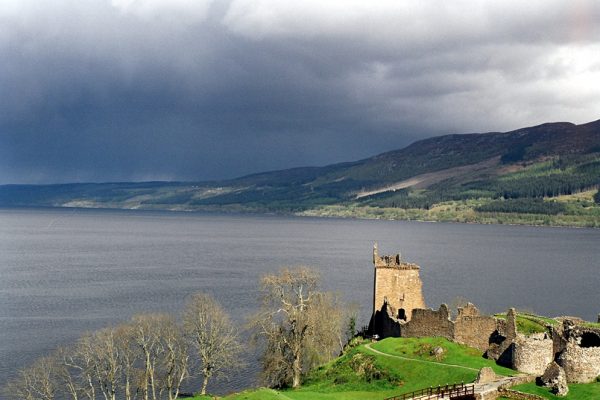
How the Loch Ness monster could help save marine life
Scientists from New Zealand’s Otago University called a news conference in early September 2019 to discuss the findings of their hunt for the Loch Ness monster’s DNA. The researchers announced that they catalogued roughly 3,000 species in Loch Ness without finding a single trace of the sea serpent of lore. They did, however, notice a large amount of eel DNA in the loch. The Guardian captured the team’s attitude by quoting Project Lead Neil Gemmell, PhD:
[M]aintaining a straight face, [Gemmell] added: “We don’t know if the eel DNA we are detecting is from a gigantic eel or just many small eels.”
While Gemmell and his team never reached a definitive conclusion on the origin of the monster legend, The Guardian did quote him on one giant “bait and switch” involving the monster sometimes known as Nessie—Gemmell’s own research.
“If you like, this has been a great big science con. We’ve been talking about science the entire time and we’re using the monsters as bait.” [Gemmell] said he hoped interest in the Loch Ness legend would raise the profile of environmental DNA research.
Despite how this story has been told online and in the popular press, the point of the study was never to track down a monster. The research used highly-sophisticated tools to detail the marine ecosystem of Loch Ness. These techniques will help define the next generation of ecological efforts, leveraging genetics to better understand and protect marine life.
Let’s dive deep on this one.

Reconstruction of Nessie as a plesiosaur outside the Museum of Nessie
Photo by StaraBlazkova at Czech Wikipedia, CC BY-SA 3.0
Monster Hunting
We want to go ahead and get the monster stuff out of the way, both to help you understand the research methods and to make sure you’re not daydreaming about Nessie when we get into the genetics.
The researchers sequenced DNA from 250 samples of Loch Ness water, collecting them at a range of sites and depths. The technique they used is the reason we’re actually talking about this subject, but for just one more moment, we’ll indulge in some cryptozoology.
For starters, of the 3,000 species the scientists located, they were genuinely surprised by the amount of eel DNA. Gemmell acknowledged the possibility eels had grown large enough to be considered sea serpents, but as for the plausibility…that’s a different story.
Gemmell was more definitive about another popular Nessie theory. Some have guessed that an elasmosaurus or plesiosaur survived the dinosaur extinction. The scientists say they found no DNA to support that theory at all.
According to Gemmell, he went into the project suspecting there was no monster, and he came out of the project with much the same view. But in the process, he says that he and his team created an impressively thorough picture of Loch Ness’s biodiversity.
eDNA
Scientists have long looked to DNA to inform conservation efforts, but as they develop more advanced tools, the applications grow enormously. One branch of that ecological research extends into eDNA, which may sound like some offshoot of email, but is actually just short for environmental DNA. New eDNA techniques allow small collections of water to give vast quantities of information about living species in the area.
In fact, Gemmell says his work will eventually lead to a publicly available database of all the species that call Loch Ness home. With a database like that, scientists can track changes in biodiversity, allowing more detailed research into the effects of climate change or invasive species.
Much like humans shed tens-of-thousands of skin cells every hour, fish and aquatic animals also leave tiny traces of themselves behind. Those traces can stay in a column of water for up to 24 hours. If you collect a sample of water (as little as a cup), you can filter it, then take the remaining pieces of DNA and sequence them. By comparing those shards of DNA to known genetic markers for aquatic species, you can get a sense of what animals have recently been in the area.
Environmental Decision Making
Better information about biodiversity can help us make smarter decisions when it comes to the environment and conservation.
For example, the National Science Foundation just issued a $20 million grant to develop tools that will monitor the coastal waters of Maine. Keeping track of which fish are present and in what kind of numbers can help create more sustainable fishing practices, securing both the ecosystem and a food source.
In fact, these tools can even help with enforcement for rules we’ve already made. This National Geographic article points out that dredging in New York Harbor is restricted when winter flounder are present. With eDNA tools, you can take a sample on Tuesday morning and know by Thursday night whether the winter flounder are back yet or not.
Tracking biodiversity is a crucial way for us to know when ecosystems are suffering; tools like eDNA measurements offer quick, efficient access to that information.
Maybe the real monsters…
…are the friends we made along the way. Or maybe they’re us. But the monsters are definitely not plesiosaurs trolling around the depths of Loch Ness. Thanks to eDNA we can be sure of that.
With some tongue-in-cheek presentation of very serious science, the team at New Zealand’s Otago University elevated an important discussion about the role of eDNA in marine conservation. With more sophisticated ways to track ecological impacts, we can create greater accountability and sustainability for understanding and protecting marine life.
To schedule a media interview with Dr. Neil Lamb or to invite him to speak at an event or conference, please contact Margetta Thomas by email at mthomas@hudsonalpha.org or by phone: Office (256) 327-0425 | Cell (256) 937-8210
Get the Latest Sharable Science Delivered Straight to Your Inbox!
[gravityform id=19 title=false description=false ajax=true][wprpw_display_layout id=8]




